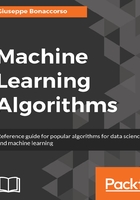
scikit-learn toy datasets
scikit-learn provides some built-in datasets that can be used for testing purposes. They're all available in the package sklearn.datasets and have a common structure: the data instance variable contains the whole input set X while target contains the labels for classification or target values for regression. For example, considering the Boston house pricing dataset (used for regression), we have:
from sklearn.datasets import load_boston
>>> boston = load_boston()
>>> X = boston.data
>>> Y = boston.target
>>> X.shape
(506, 13)
>>> Y.shape
(506,)
In this case, we have 506 samples with 13 features and a single target value. In this book, we're going to use it for regressions and the MNIST handwritten digit dataset (load_digits()) for classification tasks. scikit-learn also provides functions for creating dummy datasets from scratch: make_classification(), make_regression(), and make_blobs() (particularly useful for testing cluster algorithms). They're very easy to use and in many cases, it's the best choice to test a model without loading more complex datasets.